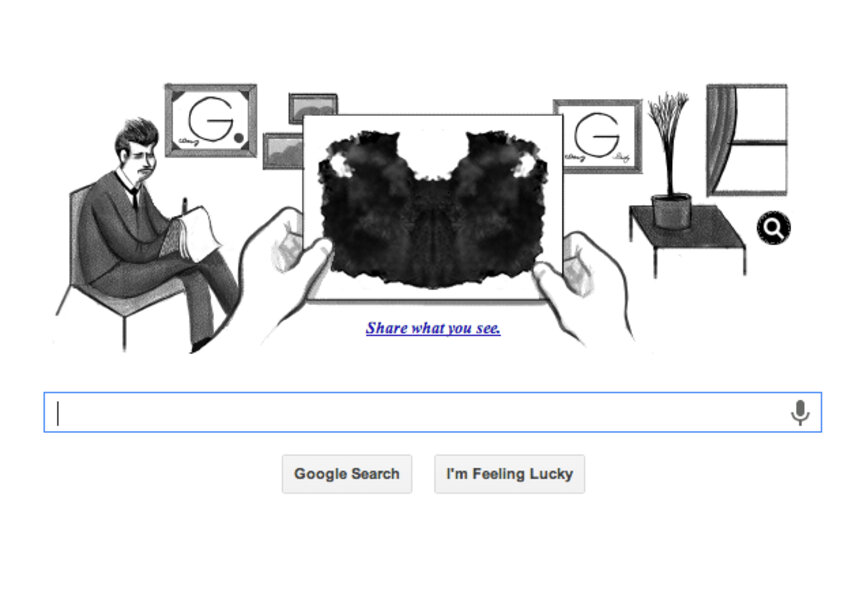Do shrinks still use Hermann Rorschach's inkblot test? Should they?
Loading...
Is that a butterfly? Or is it a woman holding a pair of scissors?
Do you perceive images of movement, of aggression, of abandonment? How long does it take you to respond? Do you focus on part of the image or take in the whole thing? Did you ask if it was okay to turn the card upside down? Are your responses exuberant or restrained?
Now, let's talk about why you responded the way you did.
Friday marks the 129th birthday of Hermann Rorschach, the Swiss psychiatrist and psychoanalyst, and Google is marking the occasion with an interactive homage to his famous 'inkblot' test.
Devised in 1921 and rivaling perhaps only the Stanford-Binet IQ test as psychology's most well-known assessment, the Rorschach test has endured, notably in areas where the science of the mind intersects with the justice system, in situations where people have an incentive to present themselves a certain way.
For instance, a 1997 study found that it was used in 48 percent of child custody cases in the United States. A 1999 study found that it was used in 28 percent of evaluations of emotional trauma.
Parole boards take prisoners' Rorschach responses into account when deciding whether or not to grant them freedom. Prosecutors use the test when deciding whether or not to bring sexual abuse charges. Juries use it in their decisions to recommend death sentences.
Proponents of the Rorschach say that the subject's responses can be scored reliably and that it provides important information – such as a person's likelihood of committing suicide – that cannot be gained through other tests. They say that the test, when used alongside more formal standardized assessments, can help provide more nuanced pictures of subjects' anxieties and fantasies, their ability to handle stress, their sexual proclivities, and, overall, how they structure their thoughts and perceptions.
The test itself consists of 10 cards with bilaterally symmetrical images, five black and white, and five with color. To call the images 'inkblots' is not quite accurate – Rorschach carefully drew each one, with the specific aim of diagnosing schizophrenia.
The cards have since been used in assessing the mental states of millions of people, and have remained nearly exactly the same through the years. On its website, Hogreffe Publishing, which has printed the cards on the same press since the 1920s, emphasizes its efforts to preserve the integrity of the scoring system by keeping each batch consistent.
Even today, each reprinting of the plates themselves requires great attention, and is done on what can now only be regarded as ancient equipment, which is carefully maintained exclusively for this purpose, so as to maintain a virtually identical reproduction of the originals. Even the weather has to be taken into account, and if it is too humid, or too dry, the printing process has to be rescheduled.
The cards themselves have remained the same, but the methods of interpreting responses have not. By 1950, there were five different methods of scoring the test. A measure of standardization came in the 1970s, when psychologist John E. Exner developed a systematic scoring system and established a baseline against which other test takers could be compared.
Mr. Exner's "Comprehensive System" includes about 100 variables, such as whether the subject focussed heavily on details instead of the whole image (a possible sign of obsessiveness), whether the subject saw images in the white spaces around the ink (hostility?), and whether the subject describes imagery of death and damage (depression?).
Exner's system subdued many, but not all, of the Rorschach's critics. In 2000, a trio of psychologists published a review of the Rorschach test, along with two other commonly used "projective" tests that seek to use ambiguity to pry open a window to the subject's unconscious mind. Writing in the journal Psychological Science in the Public Interest, Emory University psychologist Scott Lilienfeld, James Wood of the University of Texas at El Paso, and Howard Garb of the University of Pittsburgh, found that a "substantial majority" of Rorschach's measurements lacked empirical support.
The authors cited surveys that showed that psychologists agreed on only about half of Exner's 100 variables. They found that the test showed very little reliability when it came to diagnosing depression, anxiety, psychopathy, and most other conditions, with the notable exceptions of schizophrenia and bipolar disorder.
What's more, some studies have shown that Rorschach interpretations might fall victim to cultural bias. Research has shown that blacks, hispanics, and Native Americans have tended to score differently according to the Comprehensive System than white Americans.
And yet, there still might be something to the test. Writing in the Scientific Review of Mental Health Practice in 2003, Drs. Wood and Garb showed that, in addition to reliably predicting schizophrenia, certain Rorschach scores correlated with traits such as intelligence, dependency, and disordered thinking, and that the test shows some promise in aiding psychological research. "The virtues of the Rorschach," they write, "are modest but genuine."
"Paradoxically," they write, "although the Rorschach is held in disrepute by many research psychologists, it has achieved its greatest successes as a research tool."
The ongoing disagreement over the Rorschach's validity mirrors the dissonance between psychology's research and practice wings. Practitioners tend to have a greater emphasis on the inner logic of an individual's unconscious mind, whereas those seeking to advance the science of psychology seem to have more thoroughly shaken the legacy of Sigmund Freud and his intellectual descendants, focusing instead on the mind as product of biology. To be sure, there are many exceptions on both sides.
Perhaps one's acceptance or rejection of the Rorschach is itself a projective response, a measure of one's tolerance for squishy ambiguity, emotional introspection, and qualitative imprecision. Indeed, it could be that those who hastily dismiss or embrace the test are revealing something important about themselves.








